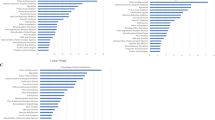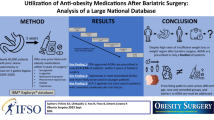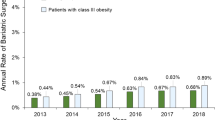Abstract
Background
Bariatric surgery leads to weight loss, but it is unclear whether surgery reduces conditions associated with obesity. We explored this by assessing the change in use of medications to treat diabetes mellitus, hypertension, and hyperlipidemia in the year following surgery.
Methods
This is a cohort study using administrative data from 2002 to 2005 from seven Blue Cross/Blue Shield Plans. We compared the mean number of medications at the time of surgery and in the subsequent year. Medication usage by surgical patients was also compared to usage by matched enrollees without surgery but with a propensity score suggesting obesity. With Poisson and logistic regression, we tested for statistical differences in usage, accounting for repeated measures and controlling for age, sex, and diabetes. We also evaluated medications expected to be less influenced by surgery (antidepressants, thyroid replacement, and antihistamines).
Results
Our cohort included 6,235 enrollees with bariatric surgery. Their mean age was 44 years with 82% women; 34% had diabetes. Medication use declined significantly by 3 months. By 12 months after surgery, medication use for diabetes, hypertension, and hyperlipidemia had declined by 76%, 51%, and 59%, respectively. In contrast, thyroid hormone, antihistamine, and antidepressant use decreased by only 6%, 15%, and 9%, respectively. Enrollees without surgery had a modest increase in medications for diabetes, hypertension, and hyperlipidemia of 4%, 8%, and 20%, respectively.
Conclusions
Medication use for three serious obesity-associated conditions decreased promptly following surgery. The clinical and economic benefits of reduced medication requirements should be considered when making decisions about the effects of bariatric surgery.

Similar content being viewed by others
References
Hossain P, Kawar B, El Nahas M. Obesity and diabetes in the developing world—a growing challenge. N Engl J Med. 2007;356(3):213–5.
Buchwald H, Avidor Y, Braunwald E, et al. Bariatric surgery: a systematic review and meta-analysis. JAMA. 2004;292(14):1724–37.
Chu SY, Bachman DJ, Callaghan WM, et al. Association between obesity during pregnancy and increased use of health care. N Engl J Med. 2008;358(14):1444–53.
Buescher PA, Whitmire JT, Plescia M. Relationship between body mass index and medical care expenditures for North Carolina adolescents enrolled in Medicaid in 2004. Prev Chronic Dis. 2008;5(1):A04.
Callahan CM, Stump TE, Stroupe KT, et al. Cost of health care for a community of older adults in an urban academic healthcare system. J Am Geriatr Soc. 1998;46:1371–7.
Finkelstein EA, Fiebelkorn IC, Wang G. National medical spending attributable to overweight and obesity: how much, and who's paying? Suppl Web Exclusives. 2003;W3:219–26.
MacDonald KG Jr, Long SD, Swanson MS, et al. The gastric bypass operation reduces the progression and mortality of non-insulin-dependent diabetes mellitus. J Gastrointest Surg. 1997;1(3):213–20. discussion 220.
Dixon JB, O'Brien PE, Playfair J, et al. Adjustable gastric banding and conventional therapy for type 2 diabetes: a randomized controlled trial. JAMA. 2008;299(3):316–23.
Pories WJ, Swanson MS, MacDonald KG, et al. Who would have thought it? An operation proves to be the most effective therapy for adult-onset diabetes mellitus. Ann Surg. 1995;222(3):339–50. discussion 350-2.
Multum Lexicon Database. https://doi.org/www.multum.com/Lexicon.htm. Last accessed February 27, 2008.
Zeger SL, Liang KY. Longitudinal data analysis for discrete and continuous outcomes. Biometrics. 1986;42(1):121–30.
Abbott K, Basta E, Bakris GL. Blood pressure control and nephroprotection in diabetes. J Clin Pharmacol. 2004;44(4):431–8.
Rubino F, Gagner M, Gentileschi P, et al. The early effect of the Roux-en-Y gastric bypass on hormones involved in body weight regulation and glucose metabolism. Ann Surg. 2004;240(2):236–42.
le Roux CW, Aylwin SJ, Batterham RL, et al. Gut hormone profiles following bariatric surgery favor an anorectic state, facilitate weight loss, and improve metabolic parameters. Ann Surg. 2006;243(1):108–14.
Nguyen NT, Varela E, Sabio A, et al. Resolution of hyperlipidemia after laparoscopic Roux-en-Y gastric bypass. J Am Coll Surg. 2006;203(1):24–9.
Yan E, Ko E, Luong V, et al. Long-term changes in weight loss and obesity-related comorbidities after Roux-en-Y gastric bypass: a primary care experience. Am J Surg. 2008;195(1):94–8.
Mauri M, Rucci P, Calderone A, et al. Axis I and II disorders and quality of life in bariatric surgery candidates. J Clin Psychiatry. 2008;69:295–301.
Rosenberger PH, Henderson KE, Grilo CM. Psychiatric disorder comorbidity and association with eating disorders in bariatric surgery patients: A cross-sectional study using structured interview-based diagnosis. J Clin Psychiatry. 2006;67(7):1080–5.
Nickel C, Widermann C, Harms D, et al. Patients with extreme obesity: change in mental symptoms three years after gastric banding. Int J Psychiatry Med. 2005;35(2):109–22.
Scholtz S, Bidlake L, Morgan J, et al. Long-term outcomes following laparoscopic adjustable gastric banding: postoperative psychological sequelae predict outcome at 5-year follow up. Obes Surg. 2007;17:1220–5.
van Hout GC, Boekestein P, Fortuin FA, et al. Psychosocial functioning following bariatric surgery. Obes Surg. 2006;16(6):787–94.
Nickel MK, Loew TH, Bachler E. Change in mental symptoms in extreme obesity patients after gastric banding, part II: six-year follow up. Int J Psychiatry Med. 2007;37(1):69–79.
Perry CD, Hutter MM, Smith DB, et al. Survival and changes in comorbidities after bariatric surgery. Ann Surg. 2008;247(1):21–7.
Huang J, Yu H, Marin E, et al. Physicians' weight loss counseling in two public hospital primary care clinics. Acad Med. 2004;79(2):156–61.
Hauner H, Koster I, von Ferber L. Frequency of 'obesity' in medical records and utilization of out-patient health care by 'obese' subjects in Germany. An analysis of health insurance data. Int J Obes Relat Metab Disord. 1996;20(9):820–4.
Hauner H, Koster I, von FL. Frequency of 'obesity' in medical records and utilization of out-patient health care by 'obese' subjects in Germany. An analysis of health insurance data. Int J Obes Relat Metab Disord. 1996;20:820–4.
Huang J, Yu H, Marin E, et al. Physicians' weight loss counseling in two public hospital primary care clinics. Acad Med. 2004;79:156–61.
Bramlage P, Wittchen HU, Pittrow D, et al. Recognition and management of overweight and obesity in primary care in Germany. Int J Obes Relat Metab Disord. 2004;28:1299–308.
O'Brien SH, Holubkov R, Reis EC. Identification, evaluation, and management of obesity in an academic primary care center. Pediatrics. 2004;114:e154–9.
Starfield B, Weiner J, Mumford L, et al. Ambulatory care groups: a categorization of diagnoses for research and management. Health Serv Res. 1991;26:53–74.
Weiner JP, Starfield BH, Steinwachs DM, et al. Development and application of a population-oriented measure of ambulatory care case-mix. Med Care. 1991;29:452–72.
Acknowledgement
This research was conducted by the Johns Hopkins University DEcIDE Center under contract to the Agency for Health Care Research and Quality (contract # HHSA290-05-0034-1-TO2-WA2, project I.D. # 20-EHC-2), Rockville, MD, USA. The dataset used in this current study was originally created for a different research project on patterns of obesity care within selected Blue Cross/Blue Shield (BCBS) plans. The previous research project (but not the current study) was funded by unrestricted research grants from Ethicon Endo-Surgery, Inc. (a Johnson & Johnson company), Pfizer, Inc., and GlaxoSmithKline. The data and database development support and guidance were provided by the BCBS Association, BCBS of Tennessee, BCBS of Hawaii, BCBS of Michigan, BCBS of North Carolina, Highmark, Inc. (of Pennsylvania), Independence Blue Cross (of Pennsylvania), Wellmark BCBS of Iowa, and Wellmark BCBS of South Dakota. All investigators had full access to all of the data in the study and take responsibility for the integrity of the data and the accuracy of the data analysis. All listed authors contributed to the design, analysis, or writing of this study, and none has conflicts of interest. The authors of this abstract are responsible for its content. No statement may be construed as the official position of the Agency for Health Care Research and Quality of the US Department of Health and Human Services.
Author information
Authors and Affiliations
Corresponding author
Appendices
Appendix A. Bariatric operations
Appendix B. Medications of interest
Appendix C. Description of the development and validation of a propensity score for obesity
Introduction
Obesity is associated with many comorbidities and disability. Obesity is typically undercoded by practicing physicians, hampering efforts for disease management or research on obesity using administrative data [26–29]. Our objective was to develop a propensity score model based on clinical data found in health plan claim files. The ultimate goal was to identify patients with class II or III obesity (BMI ≥ 35 kg/m2). For this project, this tool was used to identify a nonsurgical cohort to serve as a comparison group for a cohort of patients undergoing bariatric surgery.
Methods
We used data from “health risk appraisal” (HRA) surveys from three participating BCBS plans, which included self-reported height and weight, and linked it to claims data from 2002 to 2005 (N = 115,495). We then excluded records with any of the following:
-
<6 months coverage in the year in which the HRA was completed (N = 16,810)
-
Missing data regarding age or age < 18 years (N = 135)
-
Had a bariatric surgery claim during the study period (N = 171)
-
Had a pregnancy claim during the study period (N = 3,493)
-
BMI unable to be calculated or BMI <10 or >100 kg/m2 (N = 625)
Our final sample (N = 71,057) was randomly split into two subsamples, one for development (N = 35,529) and one for validation (N = 35,528).
Our dependent outcome was class II or III obesity, defined by a BMI of ≥35 (from self-reported height and weight). In addition to age and gender, we used ICD-9-CM diagnosis codes that we categorized using the Expanded Diagnosis Clusters (EDC) clustering system as our predictors. We also used prescription drug claims information (NDC codes) to identify additional persons under treatment for disease who may not have been identified using ICD diagnosis codes). This system for categorizing NDC codes based on the likely condition being treated is known as the Rx Morbidity Group (RxMG) system. Both of these disease markers methodologies are part of the widely used and validated Johns Hopkins ACG case-mix/predictive risk methodology (see https://doi.org/www.acg.jhsph.edu) [30,31].
We conducted bivariate logistic regression analyses to determine which covariates were associated with obesity. We then conducted multivariate logistic regression analyses in several phases using: (1) all variables, (2) stepwise regression to select variables with p < 0.10, (3) variables with odds ratios >2.0 or <0.5, and (4) variables anticipated to be associated (+ or −) based on clinical expertise. We reviewed and compared all models and selected a final model. We then tested the model in the second half of the sample. We examined the model by applying it to a large sample of enrollees in five participating BCBS plans using data from the same time period.
Results
The comparison of the performance of different predictive (propensity) models is shown in Table 8. We present the “C” statistic (based on “receiver operating characteristics” (ROC), also known as area under the curve).
In our model, the ICD-9-CM-based “obesity EDC” had a very significant and sizable predictive coefficient. (That is, this code significantly contributed information to the prediction that a person’s BMI was greater than 35 kg/m2). For case-finding purposes, in general populations, this model would be quite useful. Every person receiving bariatric surgery had this EDC code because all persons receiving a bariatric procedure required a hospital diagnosis of obesity for payment of the claim. However, we found that only about 15% of those persons with a known BMI greater than 35 kg/m2 (but without bariatric surgery) were coded as having an obesity diagnosis by their providers. Thus, the use of this diagnosis code differed among obese persons in our two study cohorts (i.e., those obese persons undergoing surgery versus those not receiving surgery). Therefore, we opted to exclude this single EDC from the final obesity propensity model.
As noted on Table 8, the final “parsimonious” model included a selection of EDC and RxMG categories while excluding the obesity EDC code. The final model had an ROC of 0.714 in the validation sample.
Table 9 presents the sensitivity, specificity, and positive predictive value for different levels of the propensity score for the final model, within the validation half of the HRA survey population. For those persons whose claims-based propensity score fell into the highest 5% percentile, the full 96% reported BMIs greater than 35 kg/m2. This very high specificity suggests that the propensity score can effectively be applied to claims data files to identify a cohort that is extremely likely to be obese.
Rights and permissions
About this article
Cite this article
Segal, J.B., Clark, J.M., Shore, A.D. et al. Prompt Reduction in Use of Medications for Comorbid Conditions After Bariatric Surgery. OBES SURG 19, 1646–1656 (2009). https://doi.org/10.1007/s11695-009-9960-1
Received:
Accepted:
Published:
Issue Date:
DOI: https://doi.org/10.1007/s11695-009-9960-1




